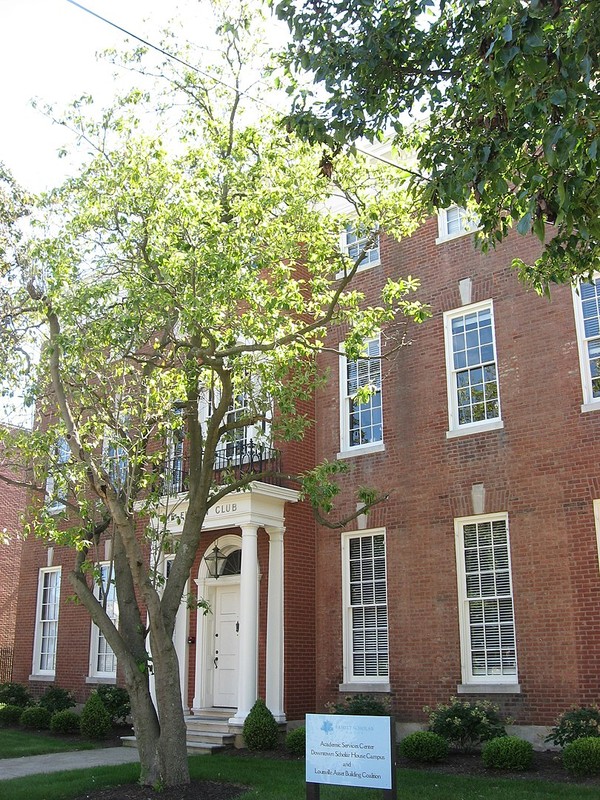The Filson Club (The Filson Historical Society)
Introduction
Text-to-speech Audio
Images
Front of the former building of the Filson Club

Backstory and Context
Text-to-speech Audio
The Filson Club building served the Filson Historical Society from 1929 to 1986, before the club moved down the street to its present location at the Ferguson Mansion on 1310 S. 3rd Sreet. The society got its start in 1884 but had to start over in 1912 when most of the original collection was sold to the University of Chicago. Though the name is tied to Filson, who authored the first book about Kentucky history, one could argue that Filson Club would not exist without Roger Clark Ballard Thruston. He restarted the club after it lost most of its materials to Chicago, organized what remained, added his collection to the Filson stock, and then paid for the majority of the costs in building the historic Filson Club building.
In 1884, the founding members honored John Filson, Kentucky's first historian, by naming the club after him; Filson published The Discovery, Settlement and Present State of Kentucke [sic] in 1784. The founding members held their first meetings at founder Reuben Durett's house. Durett also maintained the original collection of historical materials in his private library partly because Durett already possessed a personal collection of books, maps, portraits, and documents pertaining to Kentucky's history. In Durrett's will, he stipulated that his collection would pass to the club only if they found or built a suitable building to hold the materials, notably one with fireproof construction to avoid losing the historical treasures to fire. But, finding and financing a building proved difficult. So, after Durett suffered several strokes, he decided in 1912 to instead sell his collection to the University of Chicago as an assurance his collection would remain protected.
Because the Filson Club did not organize its materials well, those who shipped Durett's materials to Chicago also included much of the club's collection in the boxes. The University of Chicago sent some materials back to the club, but for all intents and purposes, the Filson Club had to start over again in 1912. Roger Clark Ballard Thruston began by cataloging the remnants of the first collection and marking it as Filson Club property. He stored the collection in his office in the Columbia Building, Louisville's second skyscraper, which enjoyed a fireproof design. Still, the Columbia Building was not suitable for holding meetings so the club had them first at Louisville's new, Free Public Library and then at Thurston's home. With the materials in one building and meetings held in another, it became abundantly clear (again) that the Filson Club needed its own space.
The move to acquire or build a permanent Filson Club facility began with Thurston's offer to add his personal collection to the Filson Club's materials and match $50,000 to any funds gathered by the club. The club responded by organizing a fund drive in 1926, but the campaign proved highly unsuccessful, so Thruston ultimately paid for 75% of the building costs. With a limited budget, the group could not buy a lot and construct a building, but they did find two residences that they could combine into one facility. The renovated and integrated spaces allowed the Filson Club to expand its collection, outreach, and promotion of research. The club expanded to the building in 1955, which coincided with an enlargement of its collection. The Filson Club building remained the organization's home until 1986, when they moved to its current home, the Ferguson Mansion on 1310 S. 3rd Sreet.
After the club moved, the original Filson Club building transitioned into a car dealership, including concrete blocks placed around the building. In 2010, a move to restore the building commenced, including removing the concrete blocks and rehabilitating the Filson Club building. The renovations gave the building new life, mainly serving as office and classroom space. Because the building remains functional, one can get a glimpse of the Filson Club's humble beginnings well before moving into a mansion in 1986. Indeed, the historical society spent nearly five decades trying to find a home, including having to restart the collection halfway through its early existence.
Sources
The Filson Historical Society. Accessed April 6, 2021. https://filsonhistorical.org/
Pierson, Joseph C. "Nominaton Form: The Filson Club." National Register of Historic Places. nps.gov. 2013. https://npgallery.nps.gov/GetAsset/2e7e2162-ea82-456c-b6e8-4e5cd0710868.
Rothert, Otto Arthur. The Filson Club and Its Activities, 1884-1922: A History of the Filson Club, Including Lists of Filson Club Publications and Papers on Kentucky History Prepared for the Club, Also Names of Members. Cambridge: Harvard University Press, 1922. Digitized in 2006 by J.P. Morton. https://books.google.com/books/download/The_Filson_Club_and_Its_Activities_1884.pdf?id=BiwUFTNDCYUC&output=pdf.
By Nyttend - Own work, Public Domain, https://commons.wikimedia.org/w/index.php?curid=29285115
